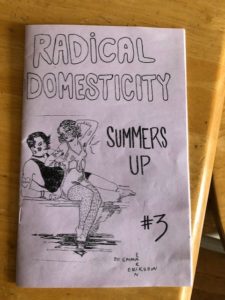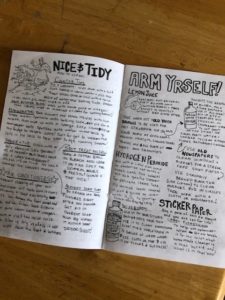When I think about drawing, I think it as a way to make things practical reality, yet drawing itself is also a process of letting reality show you what it is like. Nick Sousanis’s Unflattening [1], a dissertation in comics form, invites the readers to examine the relation between thinking, image, and text. In his commentary, “Behind the Scenes of a Dissertation in Comics Form” [2], (as well as on his website [3]), Sousanis reconnects us to the process of creating these comics pages and the ideas that once generated each image-text entity. That is to say, he invites the readers who have already read the comics to read it again differently – specifically, by seeing how those comics pages respond to the practical issues and scholarly concepts in the field of education. As he recollected in the commentary, that the terms, “education”, “schooling”, “discipline”, and “interdisciplinary”, had never been used by him while creating the comics because he does not want to create a work that “turn the reader away with specialized or politicized language”; rather, he hopes that they can “find their own way of connecting to the material” [2]. In addition to that commentary, he also mentioned this intention to reach people who are not in academia in a podcast on “Revolutionizing Thought in Comics” [4].
To me, Sousanis’s way of challenging traditional scholarship successfully revives a viewpoint that has been frequently overlooked: the picture theory of language. Through his own explanation of the beginning part of the third chapter entitled “The Shape of Our Thoughts”, Sousanis emphasizes that the picture representation itself embodies the content just as the written text does. His use of both verbal and visual metaphors in communicating mental concepts confirms this idea – that is, the two kinds of metaphors are, in his words, “equally integral to making meaning” [2]. For him, comics are more like architecture; it invites the visitors to move through the organized spatial experiences [2].
Reference
[1] N. Sousanis, Unflattening. Cambridge, Massachusetts: Harvard University Press, 2015.
[2] N. Sousanis, “Behind the Scenes of a Dissertation in Comics Form,” Digit. Humanit. Q., vol. 009, no. 4, Dec. 2015.
[3] N. Sousanis, “Spin Weave and Cut.” [Online]. Available: http://spinweaveandcut.com/. [Accessed: 01-Mar-2020].
[4] “Unflattening: Revolutionizing Thought in Comics.” [Online]. Available: https://www.nga.gov/audio-video/audio/sousanis-unflattening.html. [Accessed: 26-Feb-2020].




